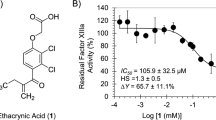Abstract
Domain 3 (D3) of human kininogens, the major cysteine proteinase inhibitors in plasma, has been shown to be the tightest binding inhibitory domain for cathepsins B and H. D3 was expressed in three fragments as its exon products as follows: exon 7 (Gly235-Gln292), exon 8 (Gln292-Gly328), and exon 9 (Gln329-Met357). Exon products 7, 8, and 9 alone as well as exon product 7 + 9 each exhibited an IC50 value 5- to 30-fold higher (5–30μM) than exon products 7 + 8 and 8 + 9 (0.9–1.3μM) for cathepsins B and H, respectively. However, in turn, the exon products 7 + 8 and 8 + 9 seemed to be less potent inhibitors than the intact D3 (10, 200 nM) or HK (200, 500 nM) molecule. These results clearly indicate that an intact molecule of HK or its domain 3 as a whole is required for optimal inhibition of cathepsins B and H.
Similar content being viewed by others
References
Assfalg-Machleidt, I., Billing, A., and Frohlich, D. (1992).Agents Actions Suppl. 38, 312–321.
Auerswald, E. A., Rossler, D., Mentele, R., and Assfalg-Machleidt, I. (1993).FEBS Letters 321, 93–97.
Barrett, A. J., and Kirschke, H. (1981).Meth. Enzymol. 80, 535–561.
Bradford, H. N., Jameson, B. A., Adam, A. A., Wassell, R. P., and Colman, R. W. (1993).J. Biol. Chem. 268, 26546–26551.
Green, G. D. J., Kembhavi, A. A., Davies, M. E., and Barrett, A. J. (1984).Biochem. J. 218, 939–946.
Johnson, D. A., Salvesen, G., and Brown, M. A. (1987).Thromb. Res. 48, 187–193.
Kirschke, H., Kembhari, A. A., Bohley, P., Barrett, A. J. (1982).Biochem. J. 201, 367–372.
Kitamura, N., Kitagawa, H., Fukushima, D., Takagaki, Y., Miyata, T., and Nakanishi, S. (1985).J. Biol. Chem. 260, 8610–8617.
Kunapuli, S. P., DeLa Cadena, R. A., and Colman, R. W. (1993).J. Biol. Chem. 268, 2486–2492.
Kunapuli, S. P., Bradford, H. N., Jameson, B. A., DeLa Cadena, R. A., Rick, L., Wassell, R. P., and Colman, R. W. (1996).J. Biol. Chem. 271, 11228–11234.
Liotta, L. A. (1986).Cancer Res. 46, 1–7.
Mason, R. W. (1986).Biochem. J. 233, 925–927.
Muller-Esterl, W., Just, H., Fritz, H., and Fresenius, Z. (1984).Anal. Chem. 317, 733–735.
Muller-Esterl, W., Fritz, H., Machleidt, W., Ritonja, A., Brzin, J., Kotnik, M., Turk, V., Kellermann, J., and Lottspeich, F. (1985).FEBS Lett. 182, 310–314.
Muller-Esterl, W., Iwanaga, S., and Nakanishi, S. (1986).Trends Biochem. Sci. 11, 336–339.
Popovic, T. Ritohja, A., Turk, V., Brzin, J., Kotnik, M., Lenarcic, B., Trestenjak, M., Begic-Odobasic, L., Macheidt, W. (1986).Biomed. Biochem. Acta 45, 1375–1384.
Salvesen, G., Parkes, C., Abrahamsen, M., Grubb, A., and Barrett, A. J. (1986).Biochem. J. 234, 429–434.
Schmaier, A. H., Bradford, H., Silver, L. D., Farber, A., Scott, C. F., Schutsky, D., and Colman, R. W. (1986).J. Clin. Invest. 77, 1565–1573.
Sloane, B. F. (1986).Proc. Natl. Acad. Sci. USA 83, 2483–2487.
Sueyoshi, T., Enjyoji, K., Shimada, T., Kato, H., Iwanaga, S., Bando, Y., Kominami, E., and Katunuma, N. (1985).FEBS Lett. 182, 193–195.
Takio, K., Towalari, N., Katunuma, D., Teller, C., and Titani, K. (1983).Proc. Natl. Acad. Sci. USA 80, 3666.
Turk, V., Brzin, J., Lenarcic, B., Locnikar, P., Popovic, T., Ritonja, A., Babnik, J., Bode, W., and Machleidt, W. (1985). InIntracellular Protein Catabolism (Khainallah, K. A., Bond, J. S., and Bird, J. W. C., eds.), Alan, R. Liss, New York, p. 91.
Wachtfogel, Y. T., DeLa Cadena, R. A., Kunapuli, S. P., Rick, L., Miller, M., Schultze, R. L., Altieri, D. C., Edgington, T. S., and Colman, R. W. (1994).J. Biol. Chem. 269, 19307–19312.
Yamaguchi, N. (1990).Cancer Res. 50, 658–663.
Author information
Authors and Affiliations
Rights and permissions
About this article
Cite this article
Bano, B., Kunapuli, S.P., Bradford, H.N. et al. Structural requirements for cathepsin B and cathepsin H inhibition by kininogens. J Protein Chem 15, 519–525 (1996). https://doi.org/10.1007/BF01908533
Received:
Published:
Issue Date:
DOI: https://doi.org/10.1007/BF01908533




